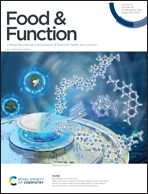Fu brick tea alleviates alcoholic liver injury by modulating the gut microbiota–liver axis and inhibiting the hepatic TLR4/NF-κB signaling pathway†
Abstract
This study first evaluated the protective effects of Fu brick tea water extracts (FTE) on alcoholic liver injury and its underlying mechanism in C57BL/6J mice. Oral administration of FTE by oral gavage (400 mg per kg bw) for 12 weeks significantly alleviated lipid metabolism disorder, reduced the activities of serum ALT and AST, decreased the expression of the liver CYP2E1 gene, and enhanced the antioxidant capacities of the livers in alcohol-fed mice (p < 0.05). FTE also relieved alcohol-induced gut microbiota dysbiosis by promoting the proliferation of probiotics such as Muribaculaceae and Lactobacillus, and subsequently increased the cecal levels of short-chain fatty acids (SCFAs) and decreased the tryptophan content of alcohol-fed mice (p < 0.05). Importantly, FTE was found to improve the alcohol-impaired gut barrier function by up-regulating the expression of the epithelial tight junction protein. Accordingly, FTE decreased the circulating lipopolysaccharide (LPS) and thus inhibited the hepatic TLR4/NF-κB signaling pathway to ameliorate alcoholic liver injury. Cumulatively, these findings shed light on the important role of the gut microbiota–liver axis behind the protective efficacy of FTE on alcoholic liver injury.



 Please wait while we load your content...
Please wait while we load your content...